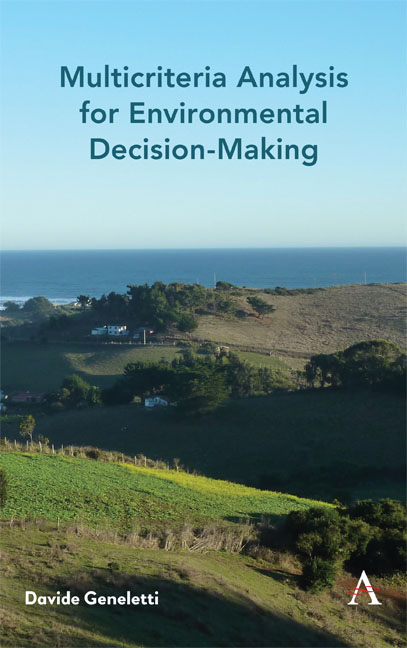Book contents
- Frontmatter
- Contents
- List of Figures
- List of Tables
- Acknowledgements
- List of Author and Contributors
- Introduction
- 1 Principles of Multicriteria Analysis
- 2 A Review of MCA Applications for Nature Conservation
- 3 Landfill Site Selection: Combining Spatial MCA with Stakeholder Analysis
- 4 Protected Area Zoning: Integrating Spatial MCA and Multi-objective Evaluation
- 5 Forest Landscape Restoration: Applying MCA to Design and Compare Options
- 6 Impact Assessment of Ski Areas: Combining GIS Indicators with MCA
- Conclusions
- Annex
- References
- Index
3 - Landfill Site Selection: Combining Spatial MCA with Stakeholder Analysis
Published online by Cambridge University Press: 16 July 2019
- Frontmatter
- Contents
- List of Figures
- List of Tables
- Acknowledgements
- List of Author and Contributors
- Introduction
- 1 Principles of Multicriteria Analysis
- 2 A Review of MCA Applications for Nature Conservation
- 3 Landfill Site Selection: Combining Spatial MCA with Stakeholder Analysis
- 4 Protected Area Zoning: Integrating Spatial MCA and Multi-objective Evaluation
- 5 Forest Landscape Restoration: Applying MCA to Design and Compare Options
- 6 Impact Assessment of Ski Areas: Combining GIS Indicators with MCA
- Conclusions
- Annex
- References
- Index
Summary
Context
Environmental decision-making problem
Landfill site selection is a complex environmental decision-making process that involves the collection and processing of information relating to environmental, socioeconomic, as well as operational aspects. There is a large body of scientific literature that addresses the location of waste disposal areas, and more in general the interaction between planning and waste management (see the comprehensive annotated bibliography presented in Hostovsky (2000)). In the last couple of decades, the combination of geographical information systems (GIS) and MCA has been routinely adopted as an approach to assess the suitability of an area to host a landfill, and consequently to select optimal locations for these facilities (Delgado et al. 2008). This approach takes advantage of both the capability of GIS to manage and process spatial information, and the flexibility of MCA to combine factual information (e.g. soil type, slope, infrastructures) with value-based information (e.g. expert's opinion, quality standards, participatory surveys). Taking into account both technical elements and people's values and perceptions is essential to build consensus around a decision, reduce conflicts and consequently pave the way to successful landfill siting interventions (Higgs 2006; Norese 2006; Petts 2001; Hokkanen and Salminen 1997; Wichelns et al. 1993).
Case study description
The case study concerns the siting of an inert landfill in Trentino, an alpine region in northern Italy. The region hosts about 90 landfill sites of limited capacity (less than 5,000–20,000 m3), and most inert wastes are disposed locally, that is, in the same municipality where they are produced. Regional guidelines concerning waste management were issued in order to comply with the national legislation, which in turn implemented the EU Landfill Directive (1999/31/CE). These guidelines set new and stricter requirements concerning the authorization to operate an inert landfill, environmental criteria for landfill sites, as well as the management of the site. The strategy devised by the new regulations consists in reducing the number of inert landfills to fewer, larger and better located sites. Most of the existing sites do not comply with the regulations, and will stop operating in the near future. Therefore, there is a need for developing and testing methods to support inert landfill site selection.
- Type
- Chapter
- Information
- Multicriteria Analysis for Environmental Decision-Making , pp. 31 - 46Publisher: Anthem PressPrint publication year: 2019



